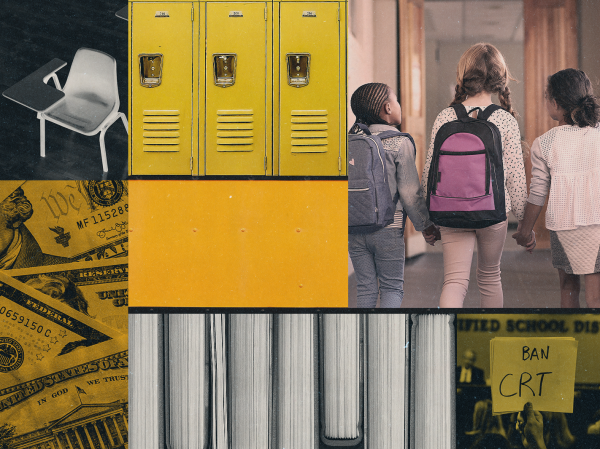Why More States Don't Have Universal Pre-K

ANDREW CABALLERO-REYNOLDS / AFP via Getty Images
California is in the middle of implementing a plan that will create a free, universal pre-K program (known as transitional kindergarten) for every 4-year-old in the state by the 2025-2026 school year. It sounds like a big, blue state priority, but it’s also a red state one. California will join states like West Virginia, Alabama and Oklahoma in aiming to provide universal preschool programs that serve all of their states’ 4-year-olds.
Welcome to the weird, patchwork world of preschool politics.
Both parties seem to agree that spending money to educate young children is a worthwhile mission, and there’s plenty of evidence that it is. Yet national plans for preschool programs have stalled in Congress. So, governors and state legislatures are taking the lead. During the current legislative term, at least 14 states are discussing preschool expansion.1 But how states choose to do that can vary widely, making uneven contributions to an already uneven system.
Over the past decade, more and more research has found that investing in early childhood education can provide long-term benefits for children that far outweigh its short-term costs. That’s especially true for children from families who cannot currently afford to send them to preschool. Policymakers, advocates and researchers hope that making these programs universal and attaching them to existing public school systems will improve their reach, prove easier for families to enroll in and improve educational quality and teacher pay.
It’s the universal part that is at issue. All but four states — Idaho, Montana, South Dakota and Wyoming — have a state-run preschool program that reaches some students, but the scope of each varies. The programs usually target specific populations, either in certain cities or certain populations of students, like children from low-income families or with special education needs.
There are several different measures of how many kids are in preschool, but each shows there are many more kids who could be there. The National Institute for Early Education Research said that approximately 39 percent of 4-year-olds were enrolled across Head Start, state-funded preschool and early childhood special education public programs nationwide during the 2020-2021 school year. NIEER and other research and advocate groups consider a program to be universal when its enrollment reaches 70 percent of all 4-year-olds in the state.2
Not all preschool programs are the same, of course. In general, as with other levels of education, the advocates and researchers I spoke with defined high-quality as having:
- Teachers who are educated at least through college;
- Opportunities for continued professional development so they can stay updated on the latest education research;
- Small class sizes and teaching assistants so that classroom student to teacher ratios remain low;
- And quality materials and curriculum.
Usually, that means more money, which makes hitting those targets even more difficult for states. Especially since there won’t be a new spigot of money specifically for preschool coming from the federal government. State budgets have been recently bolstered by COVID-19 stimulus packages, but that funding will disappear over the next few fiscal years.
From the start of his tenure, President Biden has championed early childhood education. Universal, publicly funded pre-K for 3- and 4-year-olds became part of the “social infrastructure” priorities that were included in his Build Back Better Plan. The plan initially proposed funding preschool programs through the public school systems, with the federal government picking up the entire tab in the program’s first three years. The size and scope of the plan was whittled down as it worked its way through the House, passing in November 2021 before dying in the Senate.
Now, many governors are pressing ahead, and Democrats are using Biden’s unpassed plan as a guide. Last spring, Colorado Gov. Jared Polis signed a universal preschool bill into law. Michigan Gov. Gretchen Whitmer announced a plan for pre-K for all 4-year-olds in her state-of-the-state address last week. Illinois Gov. J.B. Pritzker promised state-funded preschool for every 3- and 4-year-old during his inauguration in January. Similar promises have come from governors in Arizona, Hawaii, Maryland, and New Mexico. Most of these plans are in the early stages, and governors say that increasing funding and classroom capacity for the new grades is a multi-year process.
Build Back Better was an inspiration for California’s design, as well. “In California, people were looking to what was in that package and what was coming from the federal government and decided, like a lot of other states, that we were going to make this a priority,” said Hanna Melnick, a senior policy advisor at the Learning Policy Institute. “There was long standing support and pressure from advocates in the legislature, and then the governor's office, that all came together to make that possible, even without federal funding.” The state already has a state-funded preschool for 3- and 4-year-olds that is smaller and more targeted, as well as the federally funded Head Start, which is limited to children from families living in poverty. This new program will exist alongside those.
Republican governors are taking up the cause in many states, as well. Alabama, which earns top marks from NIEER for the quality of its programs, is opening up new classrooms this year as it moves toward a goal of 70 percent enrollment. A Mississippi lawmaker has vowed to introduce a bill to expand his state’s small preschool program over the next five years. Arkansas Gov. Sarah Huckabee Sanders listed early childhood education as one of her education priorities, the subject of an executive order she signed on her first day in office.
All this action from Republicans comes despite their party resistance to Biden’s nationwide proposal. Federalism, as always, has been the issue. Republicans did not like the quality standards that would have been mandated by Biden’s plan, as well as the shift from federal to state funding over the years of the proposal. Now, as states cobble together their own plans, state programs are likely to be quite different from one another.
Money will be one reason why. Programs that would aim to recreate Biden’s plan will be very expensive for states implementing them on their own. Alabama has been able to meet NIEER’s quality benchmarks by starting small and slowly expanding, while a program like California’s is instead focused on bringing in as many children as possible, said Allison Friedman-Krauss, as assistant research professor at NIEER. “The smaller programs are sometimes able to meet more of the benchmarks in that they're investing in fewer kids.” More of these states are trying to improve quality over time, she said.
Staffing and teacher pay will be a problem nationwide. Gov. Gavin Newsom did increase California’s education spending by 13 percent in his most recent budget, but the increase is spread across priorities that range from raises in teacher pay to boosting state college financial aid. Some districts have said it is stretching resources.
“What we're looking at is no matter how you cut it, there's just a major workforce expansion that needs to happen,” Melnick said of the California program. There’s also the question of how the expansion of California’s new transitional kindergarten program will affect an already strained workforce in other early childhood education and childcare programs, since the new program’s teachers will earn more, she said.
All of this is why many advocates hope to see the return of some or all of the components of Build Back Better. The COVID-19 recovery plans created additional money for education, but that extra money is waning just as states face a possible economic slowdown.


